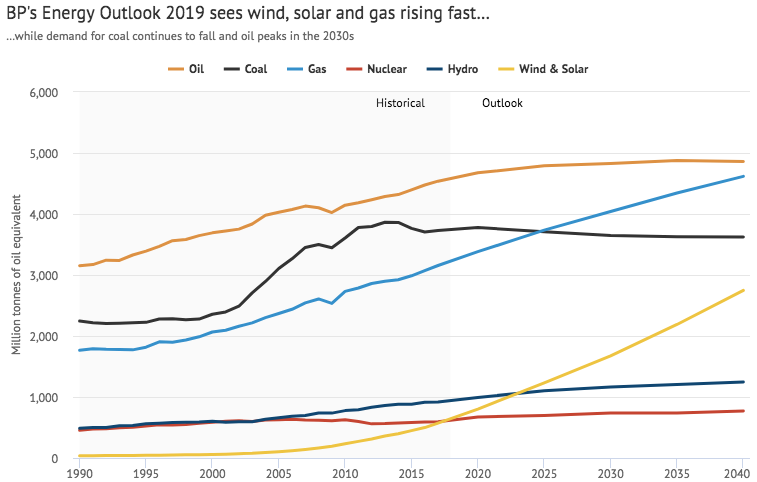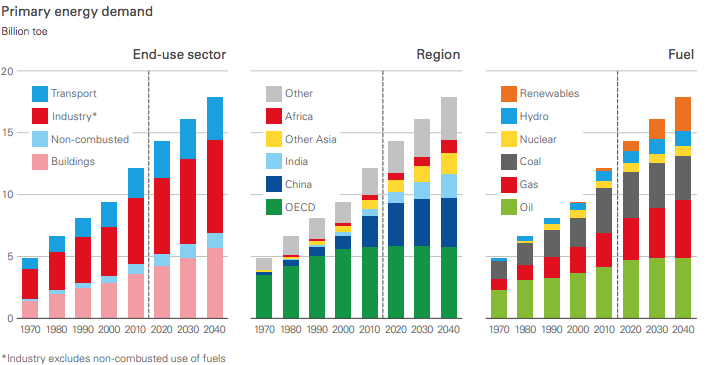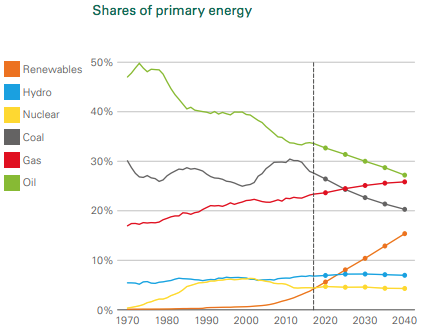According to BP’s Energy Outlook 2019, global energy demand will continue to increase because of a growing population, with rising incomes and requirements for energy—even if continued improvements in energy efficiency are aggressive. That is, BP’s Outlook expects energy consumption to go hand in hand with improvements in human progress and wellbeing—the world will need energy to continue to grow and prosper. Along with this demand growth vision, there is a growing need for fossil fuels and renewable energy to supply demand. In the agency’s forecast, natural gas, wind, and solar continue to increase worldwide through 2040, supplying 85 percent of the increase in energy demand, oil is expected to plateau around 2030 and coal is expected to decline.
The chart below shows demand for each fuel in BP’s main “emerging transitions” scenario. Wind and solar increase dramatically (yellow) and natural gas increases almost as quickly (light blue). Despite BP’s underlying energy demand assumptions, coal use (black) never regains its 2013-14 peak and oil use stops going up during the 2030s (orange), although it remains the world’s largest single source of energy through 2040.

Compared to prior year forecasts, BP increased its demand for wind and solar power, lowered its demand for coal and nuclear power, and plateaued its demand for oil, which had been increasing in past forecasts. BP expects coal demand to be about 4 percent lower than its forecast last year.
Energy Demand
BP expects world GDP to more than double by 2040 due to increasing prosperity in the developing economies. As a result, in the emerging transitions scenario, BP expects global energy demand to increase by about one-third by 2040, which is significantly slower than its rate of growth over the past several decades. All the growth in energy demand comes from the developing economies, led by India, China, and elsewhere in Asia, which together account for two-thirds of the increase.
In BP’s forecast, the industrial and buildings sectors account for three-quarters of the increase in global energy demand. BP expects transportation demand to slow sharply compared to the past, as vehicle efficiency increases. The agency expects the electric vehicle share of passenger vehicle miles to increase to around 25 percent due to the increasing importance of fully-autonomous cars beginning in the early 2020s and shared-mobility services. The number of electric vehicles is expected to total about 350 million by 2040, of which around 300 million are passenger cars. Electric vehicles make up 15 percent of all cars and 12 percent of light duty vehicles in 2040.
Electricity
Due to the continued electrification of countries, BP expects the electric power sector to consume about three-quarters of the increase in primary energy demand. Growing prosperity in developing economies is expected to lead to significant increases in electricity demand for space cooling, lighting, and electrical appliances. BP expects renewable energy to be the fastest growing source of energy, supplying half of the growth in global energy and becoming the largest source of generation by 2040. Renewables increase their share in the global power sector from 4 percent to around 30 percent, surpassing coal’s share by 2040. The share of natural gas is flat at around 20 percent.

Fossil Fuels
BP expects the demand for oil and other liquid fuels to grow in the near-term and then plateau later in the forecast. The increase in oil supply is initially provided by the United States, but OPEC production increases as U.S. tight oil is expected to decline later in the forecast. Natural gas demand is expected to grow robustly due to the increasing availability of natural gas and the continuing expansion of the liquefied natural gas (LNG) industry. Coal demand declines as OECD countries and China consume less coal, but that decline is somewhat offset by increases in coal demand by India and the rest of Asia.

Carbon Dioxide Emissions
BP expects carbon dioxide emissions from energy use to continue to increase, rising by almost 10 percent by 2040. Despite significant increases in vehicle efficiency and electrification that BP expects in the future, carbon dioxide emissions in the transportation sector continue to increase.
Conclusion
Despite efficiency improvements and the substantial increase in solar and wind power, fossil fuels (oil, natural gas, and coal) still represent over 70 percent of global primary energy supply in 2040 in BP’s main forecast. Non-hydro renewables are expected to supply just 15 percent of global primary energy in 2040. Carbon dioxide emissions are expected to increase by about 10 percent by 2040 as developing economies prosper in the future through increased energy use. All in all, the future for energy in the world is bright, and its availability to more and more world residents will improve their lives and in turn, increase the GDP.




